Assessing the Landslide Identification Capability of LuTan-1 in Hilly Regions: A Case Study in Longshan County, Hunan Province
Abstract
1. Introduction
2. Study Area and Data
2.1. Overview of the Study Area
2.2. SAR Data
3. InSAR Data Processing and Landslide Identification
3.1. InSAR Data Processing
3.2. Landslide Identification Method Considering C-Index, Slope, and Ascending/Descending Orbit Deformation
3.3. Deformation Results and Accuracy Evaluation
3.4. Landslide Identification
4. Discussion
4.1. LT-1 Satellite Landslide Identification Capability
4.2. Application Potential of LT-1 Ascending and Descending Orbit Data in Landslide Identification
4.3. Limitations and Challenges of the Study
5. Conclusions
Author Contributions
Funding
Data Availability Statement
Acknowledgments
Conflicts of Interest
References
- Shi, K.; Wang, Q.; Liu, Z.; Hu, W.; Weng, H.; Mo, Y.; Lai, T.; Huang, H. A Novel Geometric Calibration Method of Spaceborne SAR for Rugged Terrain: A Case Study of LuTan-1 Images. IEEE J. Sel. Top. Appl. Earth Obs. Remote Sens. 2024, 17, 16030–16040. [Google Scholar] [CrossRef]
- Jin, G.; Liu, K.; Liu, D.; Liang, D.; Zhang, H.; Ou, N.; Zhang, Y.; Deng, Y.; Li, C.; Wang, R. An Advanced Phase Synchronization Scheme for LT-1. IEEE Trans. Geosci. Remote Sens. 2020, 58, 1735–1746. [Google Scholar] [CrossRef]
- Hu, L.; Tang, X.; Tomás, R.; Li, T.; Zhang, X.; Li, Z.; Yao, J.; Lu, J. Monitoring surface deformation dynamics in the mining subsidence area using LT-1 InSAR interferometry: A case study of Datong, China. Int. J. Appl. Earth Obs. Geoinf. 2024, 131, 103936. [Google Scholar] [CrossRef]
- Ji, Y.; Zhang, X.; Li, T.; Fan, H.; Xu, Y.; Li, P.; Tian, Z. Mining Deformation Monitoring Based on Lutan-1 Monostatic and Bistatic Data. Remote Sens. 2023, 15, 5668. [Google Scholar] [CrossRef]
- Yang, F.; Shi, X.; Dai, K.; Zhang, W.; Yang, S.; Han, J.; Wen, N.; Deng, J.; Li, T.; Yao, Y.; et al. Utilizing LuTan-1 SAR Images to Monitor the Mining-Induced Subsidence and Comparative Analysis with Sentinel-1. Remote Sens. 2024, 16, 4281. [Google Scholar] [CrossRef]
- Cao, C.; Zhu, K.; Song, T.; Bai, J.; Zhang, W.; Chen, J.; Song, S. Comparative Study on Potential Landslide Identification with ALOS-2 and Sentinel-1A Data in Heavy Forest Reach, Upstream of the Jinsha River. Remote Sens. 2022, 14, 1962. [Google Scholar] [CrossRef]
- Liu, J.; Xu, C.; Zhao, B.; Yang, Z.; Liu, Y.; Zhang, S.; Kong, X.; Lan, Q.; Xu, W.; Qi, W. Deformation Slope Extraction and Influencing Factor Analysis Using LT-1 Satellite Data: A Case Study of Chongqing and Surrounding Areas, China. Remote Sens. 2025, 17, 156. [Google Scholar] [CrossRef]
- Strozzi, T.; Farina, P.; Corsini, A.; Ambrosi, C.; Thüring, M.; Zilger, J.; Wiesmann, A.; Wegmüller, U.; Werner, C. Survey and monitoring of landslide displacements by means of L-band satellite SAR interferometry. Landslides 2005, 2, 193–201. [Google Scholar] [CrossRef]
- Usami, S.; Ishimaru, S.; Tadono, T. Advantages of High-Temporal L-Band SAR Observations for Estimating Active Landslide Dynamics: A Case Study of the Kounai Landslide in Sobetsu Town, Hokkaido, Japan. Remote Sens. 2024, 16, 2687. [Google Scholar] [CrossRef]
- Zhang, R.; Zhao, X.; Dong, X.; Dai, K.; Deng, J.; Zhuo, G.; Yu, B.; Wu, T.; Xiang, J. Potential Landslide Identification in Baihetan Reservoir Area Based on C-/L-Band Synthetic Aperture Radar Data and Applicability Analysis. Remote Sens. 2024, 16, 1591. [Google Scholar] [CrossRef]
- Wang, Y.; Dong, J.; Zhang, L.; Deng, S.; Zhang, G.; Liao, M.; Gong, J. Automatic detection and update of landslide inventory before and after impoundments at the Lianghekou reservoir using Sentinel-1 InSAR. Int. J. Appl. Earth Obs. Geoinf. 2023, 118, 103224. [Google Scholar] [CrossRef]
- Liu, X.; Zhao, C.; Zhang, Q.; Lu, Z.; Li, Z. Deformation of the Baige Landslide, Tibet, China, Revealed Through the Integration of Cross-Platform ALOS/PALSAR-1 and ALOS/PALSAR-2 SAR Observations. Geophys. Res. Lett. 2020, 47, e2019GL086142. [Google Scholar] [CrossRef]
- Dong, J.; Zhang, L.; Li, M.; Yu, Y.; Liao, M.; Gong, J.; Luo, H. Measuring precursory movements of the recent Xinmo landslide in Mao County, China with Sentinel-1 and ALOS-2 PALSAR-2 datasets. Landslides 2018, 15, 135–144. [Google Scholar] [CrossRef]
- Delgado, F.; Shreve, T.; Borgstrom, S.; León-Ibáñez, P.; Castillo, J.; Poland, M. A Global Assessment of SAOCOM-1 L-Band Stripmap Data for InSAR Characterization of Volcanic, Tectonic, Cryospheric, and Anthropogenic Deformation. IEEE Trans. Geosci. Remote Sens. 2024, 62, 1–21. [Google Scholar] [CrossRef]
- Yang, S.; Zhang, J.; Fu, L.; Chen, C.; Liu, Z.; Zhang, W. Adaptability Analysis of Sentinel−1A and ALOS/PALSAR−2 in Landslide Detection in the Qinling-Daba Mountains. Appl. Sci. 2023, 13, 12080. [Google Scholar] [CrossRef]
- Dai, K.; Feng, Y.; Zhuo, G.; Tie, Y.; Deng, J.; Balz, T.; Li, Z. Applicability Analysis of Potential Landslide Identification by InSAR in Alpine-Canyon Terrain—Case Study on Yalong River. IEEE J. Sel. Top. Appl. Earth Obs. Remote Sens. 2022, 15, 2110–2118. [Google Scholar] [CrossRef]
- Zhang, T.; Xie, S.; Huang, B.; Fan, J.; Chen, J.; Tong, L. Detection of active landslides in central Maoxian County using Sentinel-1 and ALOS-2 data. Remote Sens. Land Resour. 2021, 33, 213–219. [Google Scholar] [CrossRef]
- Jiao, Y.; Liu, K.; Yue, H.; Zhang, H.; Zhao, F. An Innovative Internal Calibration Strategy and Implementation for LT-1 Bistatic Spaceborne SAR. Remote Sens. 2024, 16, 2965. [Google Scholar] [CrossRef]
- Tang, X.; Tao, L.; Zhang, X.; Zhou, X.; Lu, J.; Zhang, X. In-orbit application parameters test and analysis of L-band differential interferometric SAR satellite constellation. Acta Geod. Cartogr. Sin. 2024, 53, 1863–1872. [Google Scholar] [CrossRef]
- Gao, Y.; Zheng, N.; Zhang, Y.; Li, S.; Yang, H.; Bian, H.; Zhang, Q.; Zhang, S.; Tian, Y. A phase unwrapping method based on phase quality fusion estimation and information filtering. Acta Geod. Cartogr. Sin. 2024, 53, 1910–1919. [Google Scholar] [CrossRef]
- Li, H.; Li, B.; Li, Y.; Duan, H. The Stability Analysis of Mt. Gongga Glaciers Affected by the 2022 Luding MS 6.8 Earthquake Based on LuTan-1 and Sentinel-1 Data. Remote Sens. 2023, 15, 3882. [Google Scholar] [CrossRef]
- Liu, B.; Zhang, L.; Ge, D.; Li, M.; Zhou, X.; Guo, Z.; Shi, P.; Zhang, L.; Jin, D.; Wan, X.; et al. Application of InSAR Monitoring Large Deformation of Landslides Using Lutan-1 Constellation. Geomat. Inf. Sci. Wuhan Univ. 2024, 49, 1753–1762. [Google Scholar] [CrossRef]
- Yang, J.; Wang, J.; Guo, J.; Xie, H.; Feng, H. Analysis of geological hazard potential detection in Guizhou mountainous area based on L-SAR data. Sci. Surv. Mapp. 2024, 49, 174–182. [Google Scholar] [CrossRef]
- Han, J.; Yang, S.; Yang, T.; Zhu, N.; Ma, Y.; Zhang, W. Identification of potential landslide hazards in the Ankang area using L-band differential interferometric SAR satellite. Remote Sens. Nat. Resour. 2024, 36, 254–259. [Google Scholar] [CrossRef]
- Xiong, J.; Chen, T.; Yang, G.; Wang, R.; Li, M.; Zhao, L.; Chen, C. Discussion on the effectiveness of landslide hazard identification and factors affecting the effectiveness of LT-1 satellite based on InSAR technology. Geocarto Int. 2025, 40, 2461539. [Google Scholar] [CrossRef]
- Wang, Z.; Li, T.; Tang, W.; Yang, B.; Yuan, Y.; Wen, X.; Lu, J.; Li, Y. Identification Capability Analysis of Landslide Hazards for LT-1 and Sentinel-1 Using Time Series SAR Interferometry: A Case Study of Maoxian, Sichuan. In Proceedings of the 2023 SAR in Big Data Era (BIGSARDATA), Beijing, China, 20–22 September 2023; pp. 1–4. [Google Scholar]
- Xu, Q.; Dai, L.; Peng, Z.; Zhang, J.; Xiao, K.; Gong, H.; Wu, H. Characteristics and health risk evaluation of soil heavy metals in Longshan County. Geol. China 2024. [Google Scholar] [CrossRef]
- Xiao, K.; Xu, H.; Li, Y.; Guo, W.; Dai, L.; Peng, Z.; Gong, H.; Xu, Q. Characteristics and influencing factors of soil se content in cultivated land in Longshan County, Hunan Province. Environ. Chem. 2024, 43, 464–474. [Google Scholar]
- Cai, Y.; Li, J.; Wang, Y.; Yang, Q.; Zhang, Y.; Chen, Y.; Lu, P.; Wang, R. Detecting and Removing Phase Jitters for the Phase Synchronization of LT-1 Bistatic SAR. IEEE Geosci. Remote Sens. Lett. 2023, 20, 1–5. [Google Scholar] [CrossRef]
- Li, T.; Tang, X.; Li, S.; Zhou, X.; Zhang, X.; Xu, Y. Classification of basic deformation products of L-band differential interfero-metric SAR satellite. Acta Geod. Cartogr. Sin. 2023, 52, 769–779. [Google Scholar] [CrossRef]
- Li, Y.; Li, Q.; Jiao, Q.; Jiang, W.; Li, B.; Zhang, J.; Luo, Y. Application of Lutan -1 SAR Satellite Constellation to Earthquake Industry and Its Prospect. Geomat. Inf. Sci. Wuhan Univ. 2024, 49, 1741–1752. [Google Scholar] [CrossRef]
- Wang, L.; Marzahn, P.; Bernier, M.; Ludwig, R. Sentinel-1 InSAR measurements of deformation over discontinuous permafrost terrain, Northern Quebec, Canada. Remote Sens. Environ. 2020, 248, 111965. [Google Scholar] [CrossRef]
- Sha, P.; He, X.; Wang, X.; Gao, Z. Large-Scale Crustal Deformation of the Tianshan Mountains, Xinjiang, from Sentinel-1 InSAR Observations (2015–2020). Remote Sens. 2023, 15, 4901. [Google Scholar] [CrossRef]
- Zhao, F.; Zhang, L.; Wang, T.; Wang, Y.; Yan, S.; Fan, H. Polarimetric Persistent Scatterer Interferometry for Urban Ground Deformation Monitoring with Sentinel-1 Dual Polarimetric Data. Geomat. Inf. Sci. Wuhan Univ. 2022, 47, 1507–1514. [Google Scholar] [CrossRef]
- Jiang, H.; Feng, G.; Wang, Y.; Xiong, Z.; Chen, H.; Li, N.; Lin, Z. Land Subsidence in the Yangtze River Delta, China Explored Using InSAR Technique From 2019 to 2021. IEEE J. Sel. Top. Appl. Earth Obs. Remote Sens. 2025, 18, 4174–4187. [Google Scholar] [CrossRef]
- Wang, W.; Yang, D.; Li, L.; Li, W.; Feng, G.; He, L.; Xiong, Z.; Li, N.; Jiang, H.; Luo, W.; et al. Image Initial Registration Algorithm for Lutan-1 Satellite Based on Scale-Invariant Feature Transform-Like Algorithm—A Case Study of the Jishishan Earthquake. Geomat. Inf. Sci. Wuhan Univ. 2024, 50, 377–390. [Google Scholar] [CrossRef]
- Zhao, Y.; Feng, G.; Wang, Y.; Wang, X.; Wang, Y.; Lu, H.; Xu, W.; Wang, H. A new algorithm for intelligent detection of geohazards incorporating attention mechanism. Int. J. Appl. Earth Obs. Geoinf. 2022, 113, 102988. [Google Scholar] [CrossRef]
- Li, N.; Feng, G.; Zhao, Y.; Xiong, Z.; He, L.; Wang, X.; Wang, W.; An, Q. A Deep-Learning-Based Algorithm for Landslide Detection over Wide Areas Using InSAR Images Considering Topographic Features. Sensors 2024, 24, 4583. [Google Scholar] [CrossRef] [PubMed]
- Xiong, Z.; Zhang, M.; Ma, J.; Xing, G.; Feng, G.; An, Q. InSAR-based landslide detection method with the assistance of C-index. Landslides 2023, 20, 2709–2723. [Google Scholar] [CrossRef]
- Cai, J.; Zhang, L.; Dong, J.; Guo, J.; Wang, Y.; Liao, M. Automatic identification of active landslides over wide areas from time-series InSAR measurements using Faster RCNN. Int. J. Appl. Earth Obs. Geoinf. 2023, 124, 103516. [Google Scholar] [CrossRef]
- Dong, J.; Lai, S.; Wang, N.; Wang, Y.; Zhang, L.; Liao, M. Multi-scale deformation monitoring with Sentinel-1 InSAR analyses along the Middle Route of the South-North Water Diversion Project in China. Int. J. Appl. Earth Obs. Geoinf. 2021, 100, 102324. [Google Scholar] [CrossRef]
- Mu, M.; Li, Z.; Xu, B.; He, X.; Han, K.; Du, X.; Han, Q.; Wang, A. LT-1A/B Satellite SAR Geometric Calibration and Absolute Location Error Analysis. IEEE J. Sel. Top. Appl. Earth Obs. Remote Sens. 2024, 17, 16497–16510. [Google Scholar] [CrossRef]
- Li, Z.; Zhu, W.; Yu, C.; Zhang, Q.; Zhang, C.; Liu, Z.; Zhang, X.; Chen, B.; Du, J.; Song, C.; et al. Interferometric synthetic aperture radar for deformation mapping: Opportunities, challenges and the outlook. Acta Geod. Cartogr. Sin. 2022, 51, 1485–1519. [Google Scholar] [CrossRef]
- Deng, Y.; Wang, Y.; Liu, K.; Ou, N.; Liu, D.; Zhang, H.; Wang, J. Key technologies for spaceborne SAR payload of LuTan-1 satellite system. Acta Geod. Cartogr. Sin. 2024, 53, 1881–1895. [Google Scholar] [CrossRef]
- Wang, R.; Liu, K.; Liu, D.; Ou, N.; Yue, H.; Chen, Y.; Yu, W.; Liang, D.; Cai, Y. LuTan-1: An innovative L-band spaceborne bistatic interferometric synthetic aperture radar mission. IEEE Geosci. Remote Sens. Mag. 2024, 2, 22. [Google Scholar] [CrossRef]
- Chen, H.; He, Y.; Zhang, L.; Yang, W.; Liu, Y.; Gao, B.; Zhang, Q.; Lu, J. A Multi-Input Channel U-Net Landslide Detection Method Fusing SAR Multisource Remote Sensing Data. IEEE J. Sel. Top. Appl. Earth Obs. Remote Sens. 2024, 17, 1215–1232. [Google Scholar] [CrossRef]
- Wessel, P.; Luis, J.F.; Uieda, L.; Scharroo, R.; Wobbe, F.; Smith, W.H.F.; Tian, D. The Generic Mapping Tools Version 6. Geochem. Geophys. Geosyst. 2019, 20, 5556–5564. [Google Scholar] [CrossRef]
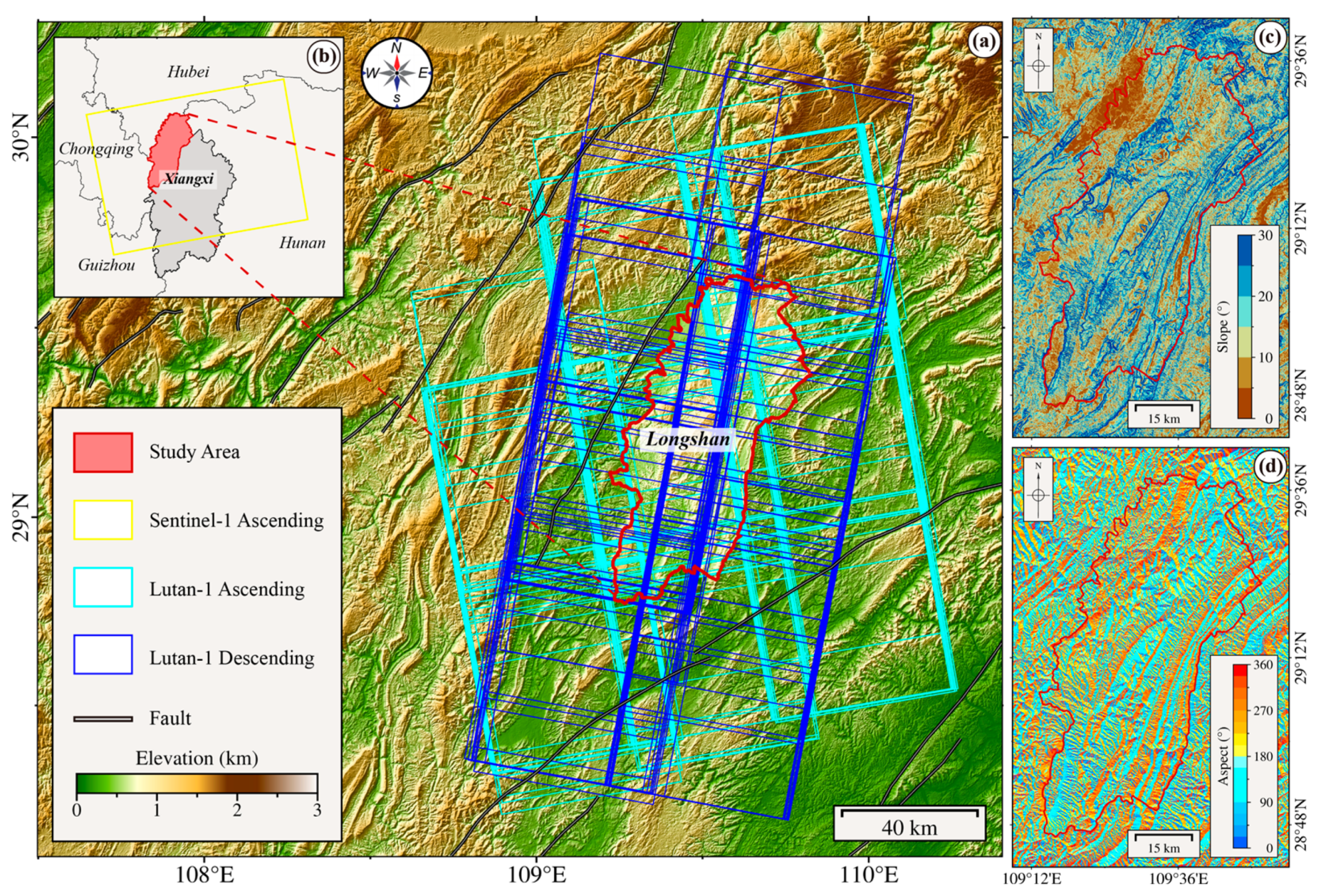
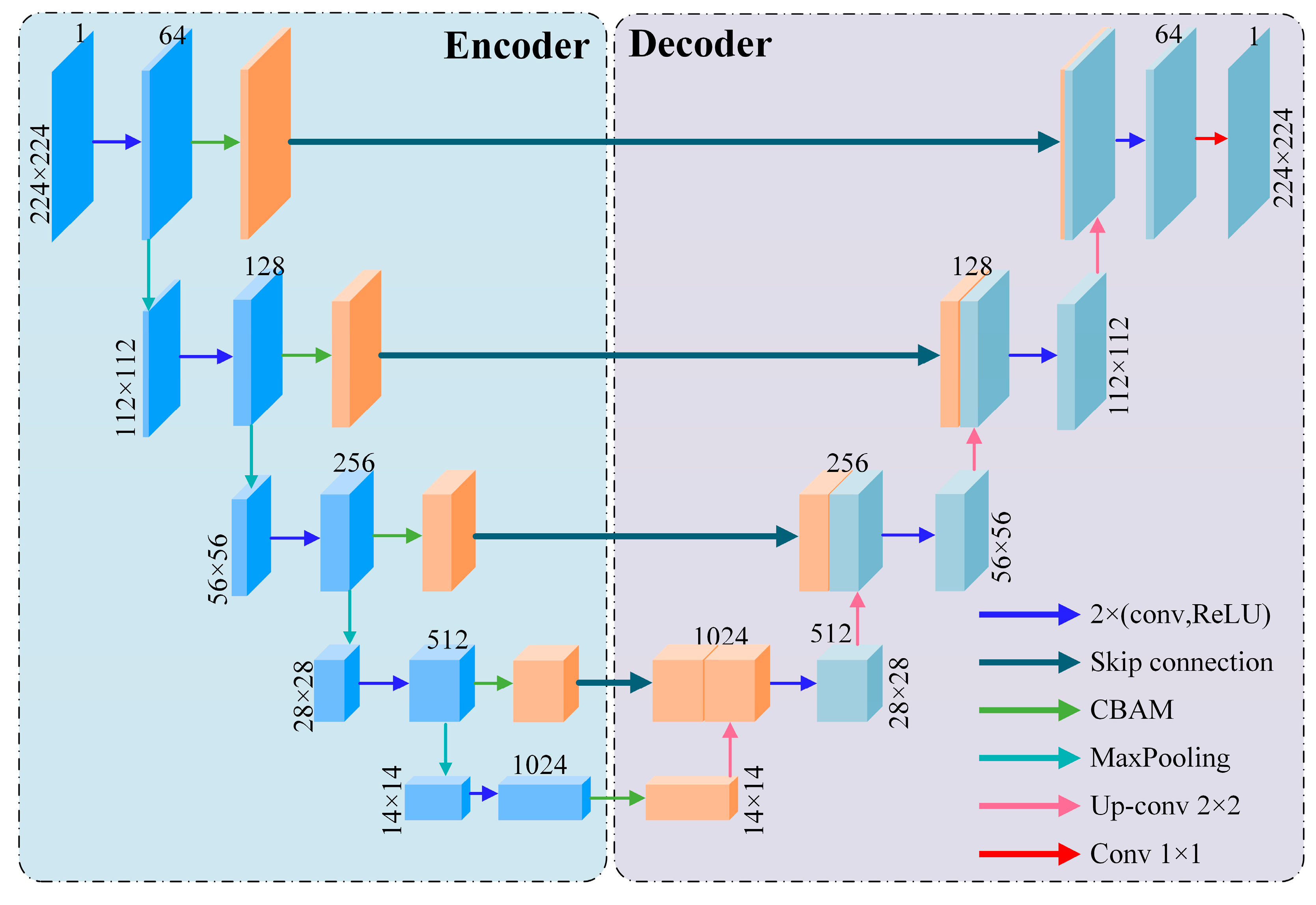
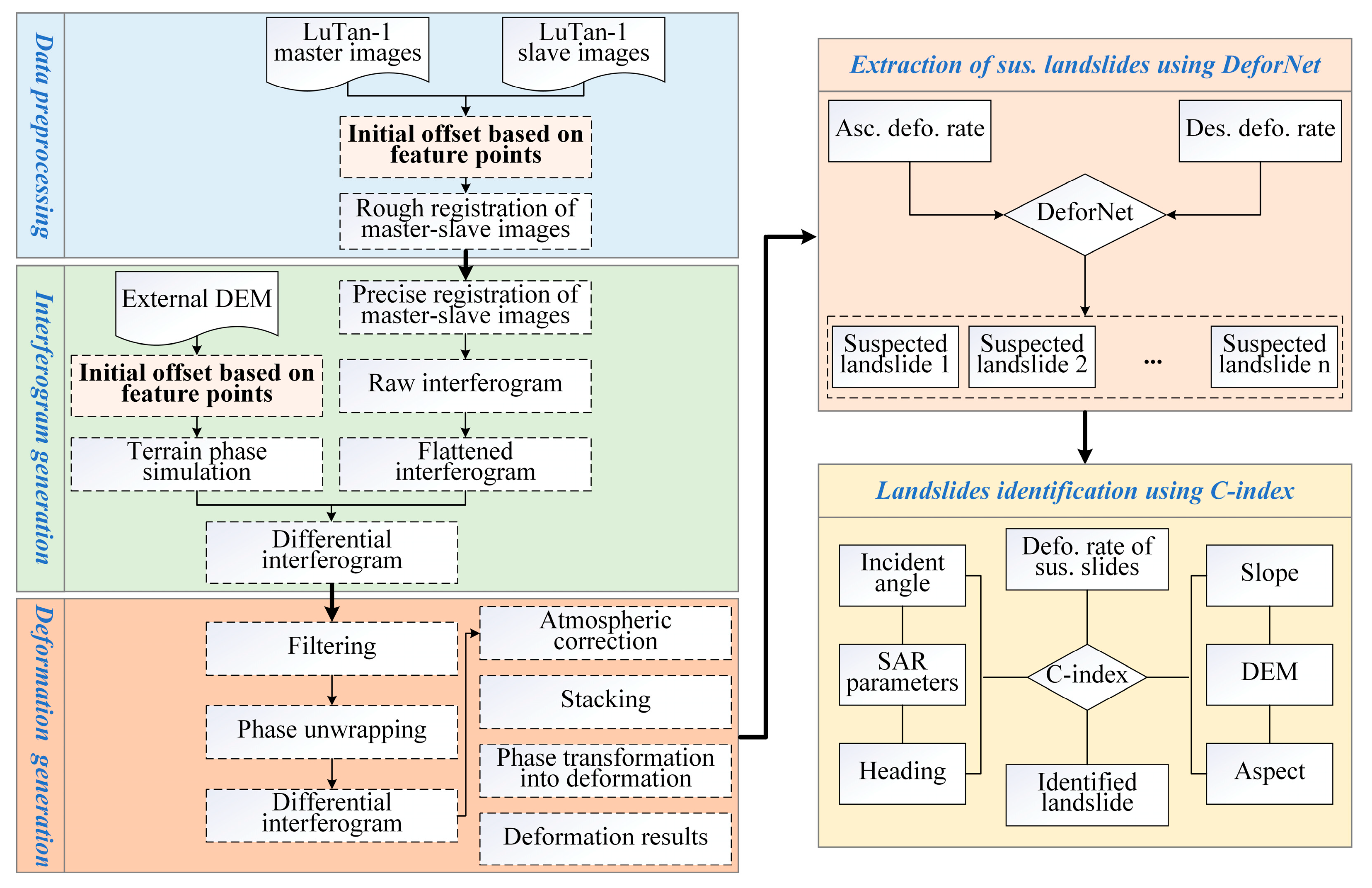
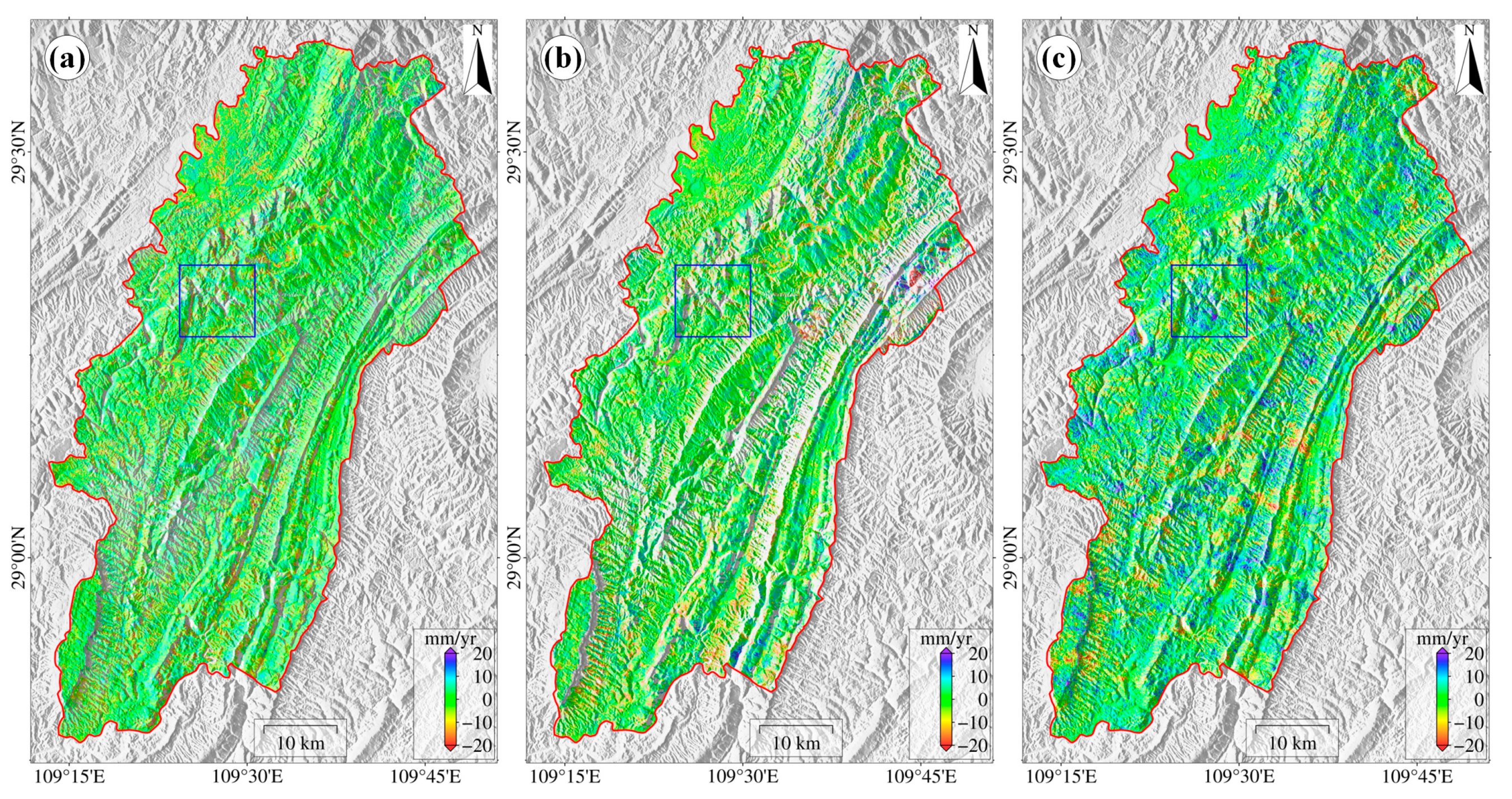
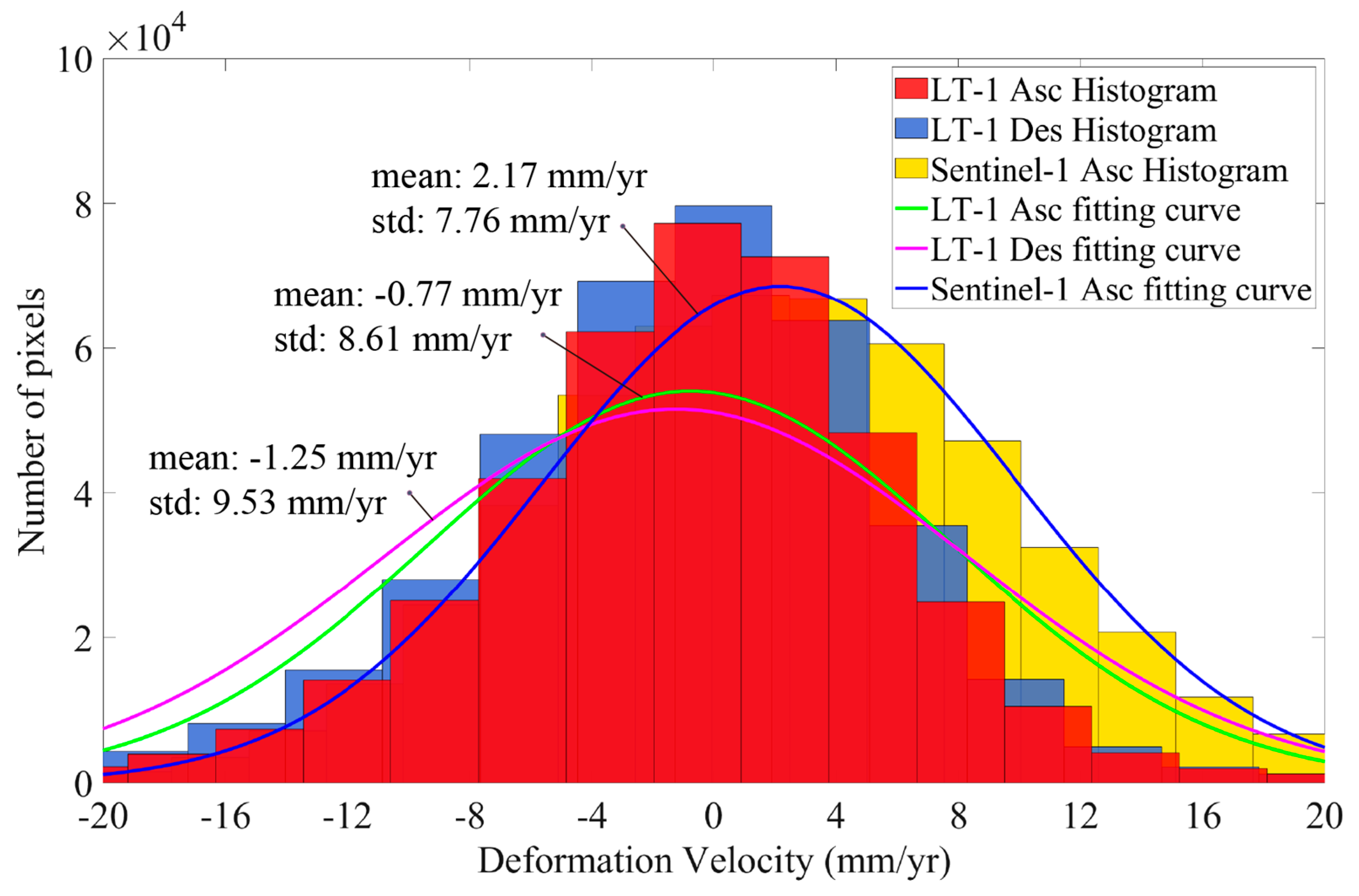
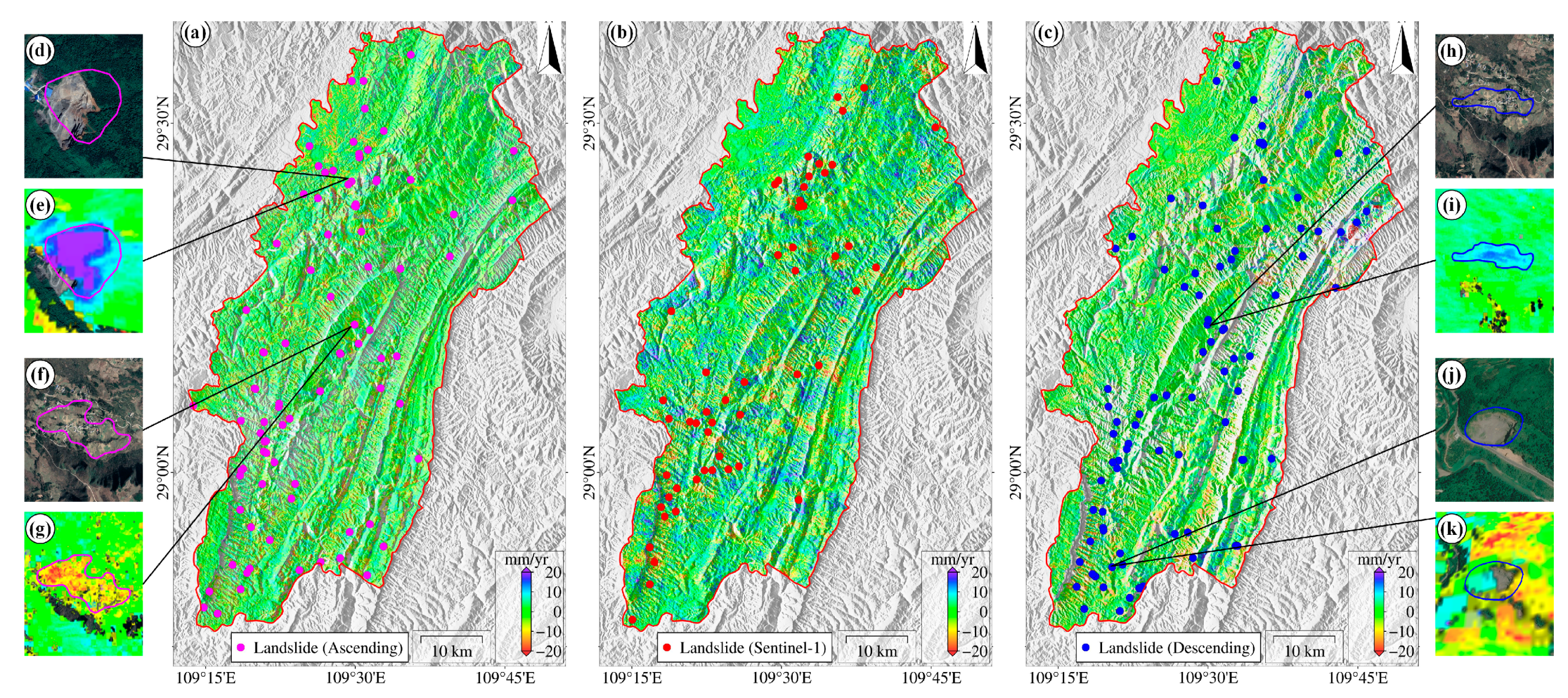

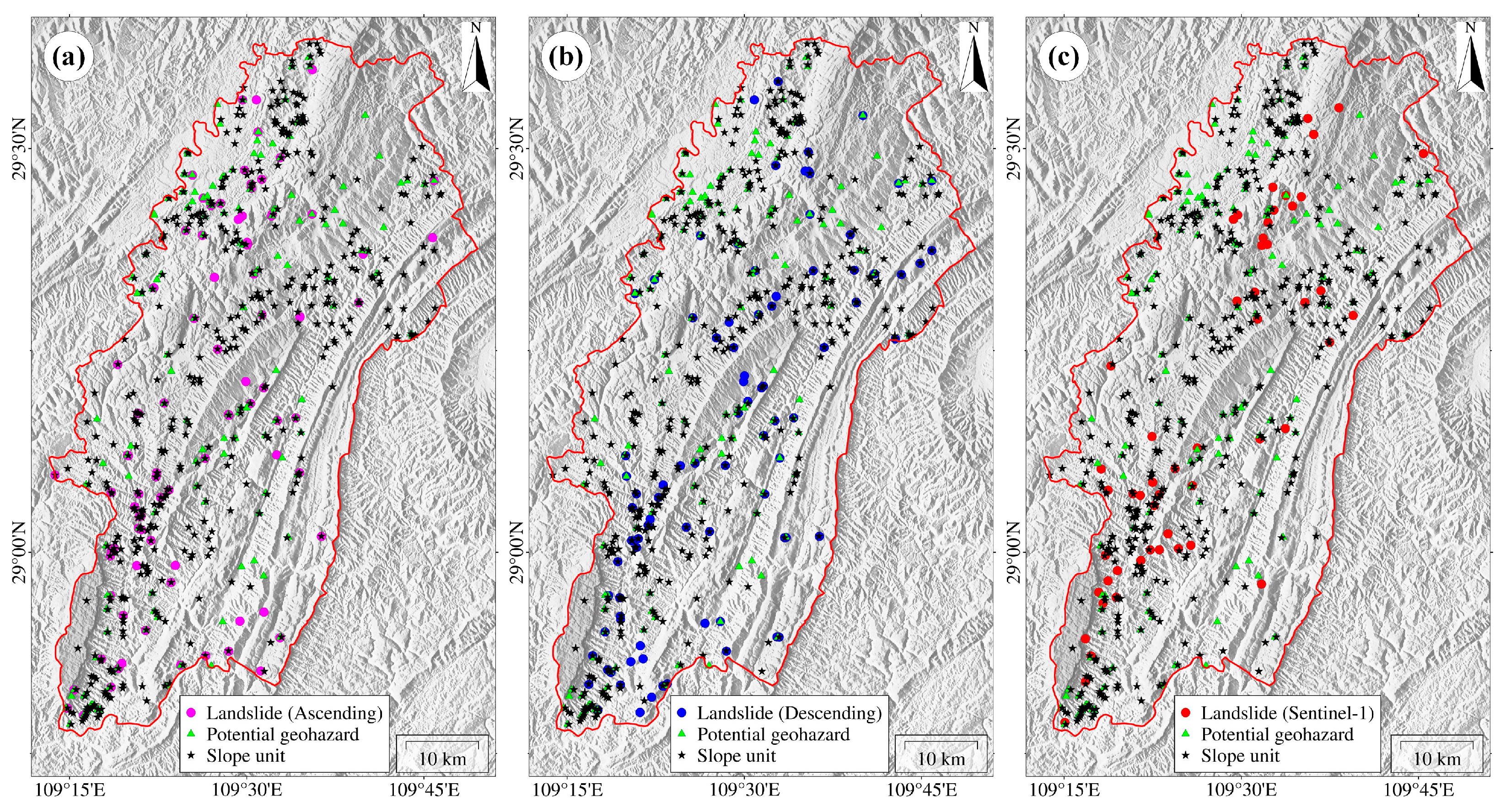

| Parameters | LT-1 | Sentinel-1 | |
|---|---|---|---|
| Band | L-band | C-band | |
| Incidence Angle | 20°–53° | 20°–46° | |
| Mode | Stripmap | IW | |
| Spatial Resolution | 3 m | 5 × 20 m | |
| Polarization | Full Polarization | Dual Polarization | |
| Revisit Cycle | 8d (single satellite) 4d (dual satellite) | 12d | |
| Orbit Direction | Ascending | Descending | Ascending |
| Number of images | 117 | 88 | 30 |
| Time | 24 June 2023–29 November 2024 | 25 June 2023–10 November 2024 | 14 June 2023–23 November 2024 |
| Project | CPU | GPU | CUDA | Python | Pytorch |
|---|---|---|---|---|---|
| Version | Intel Core i7-8700K | NVIDIA GeForce RTX 4060 | 11.8 | 3.10.14 (accessed on 19 March 2024) | 2.2.0 (accessed on 31 January 2024) |
| Data Type | Landslide | Potential Geohazard | Slope Unit |
|---|---|---|---|
| LT-1 ascending | 88 | 35 | 58 |
| LT-1 descending | 90 | 34 | 55 |
| Sentinel-1 | 53 | 19 | 30 |
Disclaimer/Publisher’s Note: The statements, opinions and data contained in all publications are solely those of the individual author(s) and contributor(s) and not of MDPI and/or the editor(s). MDPI and/or the editor(s) disclaim responsibility for any injury to people or property resulting from any ideas, methods, instructions or products referred to in the content. |
© 2025 by the authors. Licensee MDPI, Basel, Switzerland. This article is an open access article distributed under the terms and conditions of the Creative Commons Attribution (CC BY) license (https://creativecommons.org/licenses/by/4.0/).
Share and Cite
Chen, H.; Qin, Z.; Liu, B.; Peng, R.; Yu, Z.; Yao, T.; Yang, Z.; Feng, G.; Wang, W. Assessing the Landslide Identification Capability of LuTan-1 in Hilly Regions: A Case Study in Longshan County, Hunan Province. Remote Sens. 2025, 17, 960. https://doi.org/10.3390/rs17060960
Chen H, Qin Z, Liu B, Peng R, Yu Z, Yao T, Yang Z, Feng G, Wang W. Assessing the Landslide Identification Capability of LuTan-1 in Hilly Regions: A Case Study in Longshan County, Hunan Province. Remote Sensing. 2025; 17(6):960. https://doi.org/10.3390/rs17060960
Chicago/Turabian StyleChen, Hesheng, Zuohui Qin, Bo Liu, Renwei Peng, Zhiyi Yu, Tengfei Yao, Zefa Yang, Guangcai Feng, and Wenxin Wang. 2025. "Assessing the Landslide Identification Capability of LuTan-1 in Hilly Regions: A Case Study in Longshan County, Hunan Province" Remote Sensing 17, no. 6: 960. https://doi.org/10.3390/rs17060960
APA StyleChen, H., Qin, Z., Liu, B., Peng, R., Yu, Z., Yao, T., Yang, Z., Feng, G., & Wang, W. (2025). Assessing the Landslide Identification Capability of LuTan-1 in Hilly Regions: A Case Study in Longshan County, Hunan Province. Remote Sensing, 17(6), 960. https://doi.org/10.3390/rs17060960








